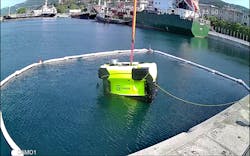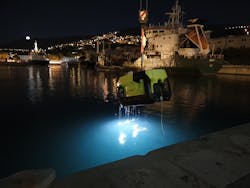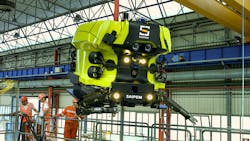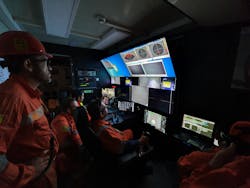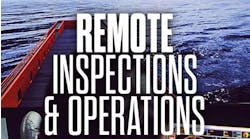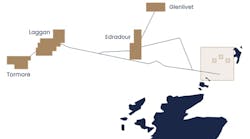Equinor’s Njord Future project in the Norwegian Sea is the first confirmed setting for Saipem’s new Hydrone subsea drones. In September, the Norwegian major awarded the company a 10-year contract to support drilling and inspections/interventions on subsea facilities at Njord and other satellite fields in the area. The program will take effect next year when production resumes through the upgraded Njord A semisubmersible platform.
Sonsub, Saipem’s business division for Life of Field, Underwater Technology and Subsea Processing, is currently putting the underwater intervention drone (UID) Hydrone-R through endurance trials at a test bed and in open sea offshore Trieste, northeast Italy. Once these have finished, the vehicle should be ready to start operations at Njord next year, performing light interventions and subsea inspections and potentially functioning autonomously for months in between scheduled maintenance.
Sonsub expects to complete development and testing of the all-electric work class ROV Hydrone-W in 2021, at which point it will be ready to undertake heavy intervention and other tasks via a tether connection to Njord A. Saipem’s Norway division will supervise the two vehicles from Njord A and from shore, via proprietary remote control technologies.
Roberto Di Silvestro, head of Sonsub, commented: “We believe that Equinor’s decision to select Hydrone was primarily for three reasons. First, our Hydrone technology is mature: SIT and EFAT [Extended Factory Acceptance Test] were completed this June and the Hydrone-R is now performing an extensive endurance campaign with the objective of reaching TRL5 [Technical Readiness Level 5] soon. Second, Hydrone-R and Hydrone-W not only meet but exceed Equinor’s technical specifications and requirements. Finally, Saipem has been working on the Hydrone program since 2015 with a global business vision and a deployment plan for various subsea fields in the world’s key energy areas. This may have given Equinor the necessary assurance that aside from the benefits of the technology we have incorporated operational inputs from other subsea applications.”
There are, in fact, three vehicles in the Hydrone series, the other being the FlatFish (or Hydrone-S), an evolution of the Flatfish concept initially developed by Shell Brasil under the Brazilian National Petroleum Agency (ANP) R&D levy program for deepwater operations. Sonsub obtained an exclusive license for the industrialization and commercialization for oil and gas applications that Sonsub is pursuing with its Brazilian robotics team in collaboration with SENAI Cimatec, a Brazilian academic center in Salvador, Bahia.
Dual-role subsea tasks
From the outset, Sonsub envisioned the Hydrone program as a set of different vehicles with different mission profiles for specific Life of Field subsea applications, Di Silvestro said. “Hydrone-R is a hybrid AUV/ROV. Like a traditional ROV, it can do interventions via manipulators, but it can also operate autonomously, as an AUV, performing inspections.”
According to Sonsub, Hydrone-R will be the world’s first commercially deployable resident subsea intervention drone, capable of remaining underwater without interruptions for up to 12 months. In this mode the vehicle provides remote operability and can be connected to subsea infrastructure via through-water communications links, covering an area within a 10 km (6 mi) radius for inspections and interventions. The distance covered could be extended through use of intermediate subsea docking stations (also part of the current trials), for re-charging of the vehicle and for mission downloads or survey data uploads. The vehicle’s embedded sensors and proprietary artificial intelligence (AI) features allow it to undertake autonomous navigation and anomaly detection on a wide range of subsea systems.
Typical tasks foreseen range from periodic general visual inspection to assessing structural integrity (including cracks and corrosion) to close visual inspections of risers, mooring lines, anodes, insulated cables and connectors. Interventions could include installing bypass valves, rectifying leaks, and connection/disconnection of flying leads.
After the first prototype vehicle was completed in June, tests followed in July on the electronics and software at Sonsub’s facilities in Venice, and the 3.5 x 1.5 m (11.5 x 4.9 ft) vehicle has since been undergoing tests at the company’s marine base in Trieste where an extensive network of subsea structures has been installed including 500 m (1,640 ft) of pipelines, and a docking station. These are positioned close to the quayside, from where the vehicle can be launched and recovered easily.
Functional tests were due to finish by the end of October. During November, the vehicle was due to be taken to another location 300 m (984 ft) offshore, in a water depth of 22 m (72 ft), to perform tasks such as hook-up of a pipeline end termination (PLET); pipe recognition and tracking; analysis profiling based on a 3D reconstruction of subsea structures; and navigating point-to-point in several kilometers of open water. Another priority is demonstrating remote control of the vehicle via its through-water communications link while in fully autonomous mode, as this is a major issue for offshore operators, Di Silvestro said. The combination of acoustics and optics are designed to allow the vehicle to position itself very close to the subsea structure. DNV GL has been overseeing the Hydrone-R’s design and qualification program.
The Hydrone-S is similar to a traditional AUV, Di Silvestro said, but with a capability to hover and to traverse longer distances of up to 50 km (31 mi). “It is designed to perform inspections, not interventions, and it is not intended to be resident in a single field – unless a giant – but to move from one field to another every few months. Its AI features allow it to operate fully autonomously for following networks of subsea pipes, flowlines and umbilicals and for more detailed inspection of subsea structures.” Industrialization of the vehicle has finished, and the prototype should be ready for first subsea trials in April-May 2020. The Hydrone-W, he added, is a fully electric, remotely operated work class ROV, able to remain resident subsea for a period of time, but not as continuously as the other two vehicles.
Sonsub has developed two other devices under the Hydrone program for periodic re-charging of the vehicles, mission and data downloads. The prototype HyBase, designed for permanent deployment, was featured in the test campaign off Trieste; the other is the HyBuoy, a smaller power/communication buoy for temporary or permanent deployment that will be powered via wave or wind energy, with subsea re-charging of the vehicle enabled via a 2-kW subsea inductive connector.
The company is also developing what Di Silvestro describes as a “flying garage” with SENAI Cimatec and Shell Brasil that would enable launch and recovery of FlatFish potentially from FPSOs or smaller support vessels. Shell/Sonsub aim to start a pilot test of the Hydrone-S/FlatFish and the ancillary equipment as soon as possible offshore Brazil, he explained, adding that other majors have also been monitoring progress of the Hydrone series development. Eni, for instance, has been supporting the test set-up at Trieste.
“In our vision, ‘Life of Field’ is an IMR engineering support concept that involves a combination of asset management and inspection/intervention. Typically, oil companies have commissioned annual inspections of their subsea assets, but in some cases, these are only performed every three years. And these campaigns have not been generating sufficient information for the industry’s present needs. If, however, you can provide low-cost inspection with a resident Hydrone, you can then start generating large volumes of ‘big data’ that allow you to really monitor any changes in the subsea asset. You can then do preventive intervention or predictive maintenance.
“When you design a pipeline and riser network to last for 25 years, you are forced to make a number of conservative assumptions, all of which leads to quite a constant capex. But if you can reduce the level of uncertainty, you can also reduce capex over the life of the field: the Hydrone-S, for example, can be configured to perform dialogue and analysis, using the data it has collected to assess the reliability of the subsea infrastructure. This is part of a movement within the industry towards an Internet of Subsea Things.” •
